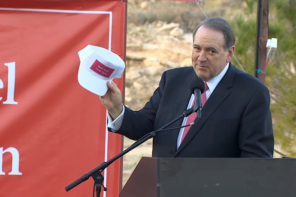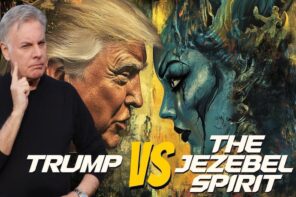Lance Wallnau, a prominent Apostle/Prophet in the Neo-Charismatic New Apostolic Reformation, had an unusual Easter message this year. Rather than a traditional message of hope and eternal life, he issued an imprecatory prayer and a dark prophecy.
Claiming to have heard “prophecies lately about sudden deaths,” Wallnau himself prophesied, “In May, you’re going to see some of the disciplinary hand of God come down upon those people that have been standing in the path of what he wants to do.” Wallnau’s imprecatory prayers—or petitions for God to curse or in some cases eliminate one’s enemies—came in response to the criminal indictment of Donald Trump and suggested that God’s answer to these prayers might come in the form of a “backlash… by the American people.”
This would be concerning enough in light of Wallnau’s prominence (on Michael Flynn’s ReAwaken America tour, for example), but it appears to be a trend. The week before, Andrew Whalen of Texas-based Vanquish Prayer Warriors had also prophesied vigilante violence. On an April 3rd episode of Elijah Streams TV, he said that God had given him a dream in which he told Donald Trump that his greatest desire is to see “Obama and Hillary hanging from a rope.” In fact, he added, God confirmed that, “that’s what justice is demanding.” Unsurprisingly, options on his Vanquish Prayer Warriors website include “Special Forces,” “War Room Writings,” and “OP. Fury” (i.e. “Operation Fury,” a “prayer siege”).
The disturbing claims that God is calling his people to organized vigilante violence is happening in the context of the evolving theology of the New Apostolic Reformation. As we’ve reported here at RD, its unusual theology, church offices, and organizational structures promote a vision of End Times Christian dominion, via conquering the metaphorical seven mountains of cultural influence—family, government, religion, business, education, arts & entertainment, and media. Such claims also suggest that the relative lull following January 6th may be over, and that some NAR leaders may be readying for a fresh round of revolt.
The spirit of January 6th
This End Times movement is well underway and is being felt throughout society. At least since the January 6th insurrection, there’s wide recognition that the stability of constitutional democracy is at stake. Less well recognized (although reported here at RD) is the role of NAR in the events leading up to January 6th. Even less well known is how NAR theology makes it politically tick. But sound knowledge of these formidable opponents of democracy is simply not optional in this volatile time.
Briefly, increasing numbers of Pentecostals and charismatics since World War II believe that a global End Times army is gathering and building strength. In fact, it’s this feature of the Dominionism of the NAR that animates much of the politics of the Christian Right.
It is said that this global legion will first take dominion over the earth and establish the Kingdom of God. It features the rise of what are called the “Manifest Sons of God”—an elite mobilization of Christians who will have supernatural powers and will ultimately defeat Satanic forces. Accounts vary as to exactly how and when these things will unfold. But many believe they are well underway.
As we shall see, there’s a relationship between what’s termed “spiritual warfare” and physical warfare. NAR leaders increasingly refer to Democrats, liberals, feminists, and LGBTQ+ people—i.e. anyone with a different political, religious, or gender identity—as demonic, and blame them for societies’ problems.
“Social science since World War 2 and the Nazi genocide has shown that under specific conditions, virulent demonization and scapegoating can and does create milieus in which the potential for violence is increased,” Chip Berlet of Political Research Associates* wrote in 2014. “What social science cannot do,” he averred, “is predict which individual upon hearing the rhetoric of clear or coded incitement will turn to violence.”
Berlet’s essay was titled “Heroes Know Which Villains to Kill: How Coded Rhetoric Incites Scripted Violence.” Indeed, villain identification has been going on for a long time, and NAR leaders are now featuring ancient scripts for modern violence and religious war. We hear it in the form of imprecatory prayers by religious and political leaders drawn from biblical texts calling on God to smite all enemies. We also hear it in the blowing of shofars at events that are intended to confront demonic elements in society, notably at the Jericho March that preceded the invasion of the US Capitol on January 6th.
This is the vision of the leg of Dominionism most visibly associated with NAR. It’s important for reporters, scholars and, well, citizens in any and every country, to recognize that this obviates and transcends conventional categories and understandings of both evangelical Christianity and politics.
For many, it’s the legacy of a mid-twentieth century offshoot of Pentecostalism called the Latter Rain Movement that makes the NAR sound strange; and for some—too strange to be taken seriously. And yet, despite its role as a mobilizing force in Pentecostal and charismatic Christianity—the largest growth sector in both American and global Christianity—the NAR is poorly understood and seldom mentioned.
God is creating a force that can’t be stopped
The New Order of the Latter Rain (more commonly called the Latter Rain Movement) grew out of Pentecostalism in Canada in the 1940s. The term comes from the biblical book of Joel, and refers to an outpouring of the Holy Spirit. Its particular vision for dominion predates that of the seminal theologian of Christian Reconstructionism, R.J. Rushdoony, who didn’t begin to publish his influential vision of dominion until later in the 1950s. The widespread influence of the Latter Rain movement helps in part to explain why, in the 1980s, Pentecostal and charismatic leaders were able to find political common ground with other evangelicals, including conservative Reformed leaders like the Christian Reconstructionists.
They arrive at their shared goal of dominion via different and not always consistent theological paths. This process, under the auspices of the Coalition on Revival, is what made the evangelical wing of the contemporary Christian Right possible. Following one 1987 Reconstructionist/Pentecostal dialogue, one Reconstructionist leader Rev. Joseph Morecraft of Georgia exclaimed, “God is blending Presbyterian theology with charismatic zeal into a force that cannot be stopped!”
A number of scholars and journalists across a wide range of interests and concerns have written about the significance of the Latter Rain.** This is notable in light of the dearth of contemporary reporting on the Dominionism of NAR, a dearth that effectively erases the past.
Of course, all of this is not entirely new. Indeed, the idea of dominion has roots in the 19th and early 20th century—although the terms “dominion” and “dominionism” came later. Early 20th century faith healer John Alexander Dowie, founder of the Christian Catholic Apostolic Church and the theocratic city of Zion in Illinois, held to what today would likely be seen as dominion theology. In 1902, in his journal, Leaves of Healing, Dowie explained:
Zion City is founded and is being built, for the purpose of the extension of the Kingdom of God upon the earth. It is to this end that it is made a City where God shall rule in every department of family, industrial, commercial, educational, ecclesiastical, and political life.
Zion was also the birthplace of James Gordon Lindsay, an early Latter Rain proponent and later the founder of Christ for the Nations Institute in Dallas. Perhaps its most famous graduate (and later executive director) is Apostle Dutch Sheets, a major figure in NAR—as well as in the January 6th insurrection. (As Matthew Taylor and Brad Onishi have reported, Sheets and other top apostolic leaders attended planning meetings in the White House).
The war for dominion will be no picnic
Sheets, who is also driven by the vision of the Manifest Sons of God, rallied for taking the seven mountains of Dominion at a 2011 gathering which also featured such top apostles as Chuck Pierce of Texas, the late C. Peter Wagner of Colorado, and Mary Glazier of Alaska. He proclaimed “a kingdom-minded, apostolic-led” movement which will be a physical and not just a metaphorical army of which Jesus will be “the commander-in-chief.”
“And,” he declared, “there is no force on Earth or below the Earth that is going to be able to stop what [God] is about to do with us.”
“Creation is waiting for the manifestation of the ‘huios,’ [or] sons of God,” Sheets explained, “because the sons of God are going to be authorized to deal with the planet.”
He called this seizing of political, governmental and cultural authority, a “reformation transformation.”
“When the ecclesia [by which he means a militant, commanding, supernatural Church] starts ruling,” he continued, “nature comes into alignment. It rains when it is supposed to rain. It doesn’t rain when it’s not supposed to rain. Storms don’t come and destroy your produce and your flocks. Earthquakes don’t happen. They happen when things are out of order and there is no ecclesia ruling.”
Sheets underscored the dominionist view of the difference between the pastoral and the governmental in a personal anecdote. When his wife at one time suggested that they host a church picnic so people could get to know each other he responded:
“Meet people! I don’t want to meet people. I don’t wanna know ‘em. You see ‘em as somebody to love. I see ‘em as a potential soldier. I don’t even need to know their name. I just need to know: Private First Class; Sergeant; Colonel; Lieutenant. I just need to know what is your function, and where are you going to serve in the army? That’s all I care about.”
Joseph Mattera of Brooklyn, New York, the Convening Apostle of the U.S. Coalition of Apostolic Leaders, agrees with at least one part of Sheets’ teaching about the sons of God. He wrote a blog post in 2018 which, he said, “is based on notes I took from a teaching conducted by Dutch Sheets, who did a superb job of simplifying this message about the Kingdom of God.”
Like Sheets, Mattera emphasized that new Christians are “immature” children of God. But when the mature sons (huios) “are fully manifest, then the world will operate the way it was always meant to be; it will rain when it is supposed to rain; the weather patterns will be what they are supposed to be, etc.”
Another example comes from Vishnu Jetnarayan, a prophet who served as the 2022 campaign manager for Pennsylvania GOP gubernatorial candidate Doug Mastriano. Jetnarayan preached in 2013:
“I’m going to teach you Rule. I’m going to teach you Dominion. I’m going to teach you how to subdue. And the plan goes into place… When the answer of Dominion, of rulership, lies in the hearts of the sons of God.”
It is extraordinary that the closest staff of a major party candidate holds such fiercely anti-democratic views. What’s also extraordinary is not that Mastriano lost big by conventional standards—but that he did as well as he did and is now the most prominent GOP politician in the state. His losing campaign has launched a movement—propelling a statewide political wave in advance of his likely campaign for the U.S. Senate in 2024, and lifting the boats of numerous candidacies for lesser offices.
Super powers in the end times
The elite End Times army as described in various books of the Bible, and envisioned by the leaders of the Latter Rain Movement and its descendants, has been varyingly called the overcomers, forerunners, the man-child, the Manifest Sons of God, Joel’s Army, the Saints, and Special Forces.
And although this powerful idea has been expressed differently by different leaders over time—which can be confusing to anyone who isn’t an insider—it has a common source.
The Latter Rain movement began in North Battleford, Saskatchewan, Canada, following three months of Bible study, prayer, and fasting by Pentecostal students at Sharon Children’s Homes and Schools in February, 1948. Weary of what they felt was a “spiritual drought” in institutional Pentecostalism, they were in search of fresh spiritual experience. This is a driving aspect of NAR to this day.
This anti-denominationalism led to accusations that the movement was taking members and churches out of institutional Pentecostalism. This was certainly a factor when the General Council of the Assemblies of God in the U.S. passed a resolution in 1949 saying, among other things: “That we disapprove of those extreme teachings and practices which… [are] unfounded Scripturally.”
Edith L. Blumhofer, noted historian of the Assemblies of God (the nation’s largest Pentecostal denomination), observed however, that “no ministers had been disfellowshipped” for these things and that “the New Order did not present a major threat to the Assemblies of God.”
But that was then.
The most controversial beliefs and practices of the Latter Rain (many of which were still ordinary Pentecostal practice) was certainly the five-fold ministry (i.e., the five church offices of Apostle, Prophet, Pastor, Teacher, and Evangelist) as called for in the book of Ephesians for first century Christians. This belief is, after all, an attack on pretty much the entire history of institutional Christianity. But even then, the most controversial belief was the expectation of the Manifest Sons of God.
The controversy (in addition to the global networks and churches) grew over time such that by 2000 the General Council of the Assemblies of God was compelled to revisit their approach to “deviant teachings.” Among these were the beliefs that modern day apostles and prophets should have authority over the church; Dominion theology and Kingdom Now doctrine; and Manifest Sons of God.
The birth of the supernatural Manifest Sons
Latter Rain revivalists, such as George Hawtin, believed in the advent of a faithful remnant, a group of “overcomers” equipped to prepare the church and the world for the return of Jesus. The “Man-Child” in the Book of Revelation was understood as a reference to the Manifest Sons of God. Yet, as radically different as some of the Latter Rain revivalists were in their time, they were not the first to feature this idea.
Early Pentecostal leaders such as Charles Parham also used the terms “Man-Child” and “overcomers” to describe this elite group within the church. Parham taught that they were forming the corporeal “Body of Christ” on earth, and would come to possess the Kingdom of God. They would rule and reign with Jesus over the nations upon his return to earth. Blumhofer notes that Ivan Q. Spencer, who founded the Elim Bible Institute in upstate New York in 1924, and others associated with Elim, “all thought they were ‘manifest sons of God.’”
Like Parham, George H. Warnock declared in his influential 1951 book, The Feast of Tabernacles, that the second coming of Jesus will not be in the form of an individual, but rather that, “Now Christ will appear in His Church the Body.”
Perhaps the most fantastic part of the vision of some early Latter Rain leaders is how Christians would incarnate the actions of Jesus and exhibit supernatural abilities. Warnock and other florid preachers offered visions that can sound like something out of Marvel comics. Warnock detailed, for example, how teleportation might come in handy when “the authorities… send the police” to arrest people who are “so boldly preaching Christ, and working the works of God.” The authorities would not find them because they “will have disappeared.” Warnock added that swords, bayonets, and even atomic weapons would be ineffective against them.
When it comes to apocalyptic visions, people sometimes differ on important details, which can make it hard to generalize about the meaning of the Latter Rain. Some see Jesus as leading the charge of the elite Christian brigade, while others envision that the brigade literally is the body of Christ in battle. Warnock characterized these battles as defensive. Others foresee a war of vengeance against sinners, unbelievers, and those otherwise out of sync with God’s word, and appear to be preparing themselves—which is, of course, the main concern here as this rhetoric has become increasingly commonplace.
Some might be tempted to consider all this as little more than an academic, but not particularly consequential, curiosity. But an understanding of the origins of the Latter Rain movement and how it informs the most forceful voices and organizing efforts of the NAR, is critical to understanding the depth and breadth of the rising anti-democratic movement in the United States and the world.
—
The second half of this series dives deeper into how the vision of the Manifest Sons of God animates the New Apostolic Reformation—and considers the inherent danger when people begin to think of themselves as gods.
*PRA is Religion Dispatches’ parent organization, though RD remains editorially independent.
**From progressive scholar John Weaver, to Liberty University theologian Tommy Ice, to the Southern Poverty Law Center, to journalist Elle Hardy at The New Republic, and Bruce Wilson, here at RD. Researcher Rachel Tabachnick laid out an explanation of the Latter Rain approach to dominion, and how this in turn informed the Dominionism of the New Apostolic Reformation, in a series of blog posts at the now defunct blog site Talk to Action in 2011. [Full disclosure: Frederick Clarkson was the co-founder of the site.]





